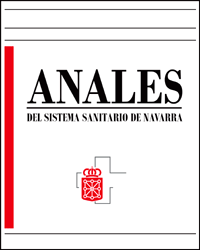Condrolisis idiopática de cadera. Evolución a largo plazo
DOI:
https://doi.org/10.23938/ASSN.0262Palabras clave:
Condrolisis. Idiopática. Cadera. Rigidez. Tratamiento conservador.Resumen
La condrolisis idiopática de cadera es una rara condición que se presenta durante la adolescencia. Se caracteriza por dolor y cojera producidos por una pérdida acelerada del cartílago articular con una disminución del grado de movilidad llegando a rigidez. La historia va desde la resolución espontánea completa a la anquilosis. El tratamiento recomendado actualmente es el conservador. Se presenta el caso clínico de un paciente de 11 años de edad con un cuadro clínico de 2 años de evolución tórpida de dolor inguinal izquierdo acompañado de cojera y rigidez. Se instauró reposo, descarga, analgésicos y rehabilitación sin mejoría inicial. Posteriormente recibió tratamiento conservador con AINE, periodos de descarga de la extremidad, tracción blanda hospitalaria, tracción ambulatoria nocturna y rehabilitación, recuperando la movilidad y marcha normal 6 años después del inicio de los síntomas. Catorce años más tarde el paciente hace una vida normal, asintomático y con movilidad simétrica de ambas caderas.
Descargas
Citas
1. MORRISSY RT, WENSTEIN SL. Lovell and Winter's pediatric orthopaedics. 6th ed. Philadelphia, PA: Lippincott, Williams and Wilkins; 2006. pp. 1147-1155.
2. FRANÇOIS J, MULIER M. Idiopathic chondrolysis of the hip. A case report. Acta Orthop Belg 2007; 73: 653-657.
3. SEGAREN N, ABDUL-JABAR H, SEGAREN N, HASEMI-NEJAD A. Idiopathic chondrolysis of the hip: presentation, natural history and treatment options. J Pediatr Orthop 2014; 23: 112-116.
https://doi.org/10.1097/BPB.0000000000000019
4. DALUGA DJ, MILLAR EA. Idiopathic chondrolysis of the hip. J Pediatr Orthop 1989; 9: 405-411.
https://doi.org/10.1097/01241398-198907000-00005
5. IPPOLITO E, BELLOCCI M, SANTORI FS, GHERA S. Idiopathic chondrolysis of the hip: an ultrastructural study of the articular cartilage of the femoral head. Orthopedics 1986; 9: 1383-1387.
https://doi.org/10.3928/0147-7447-19861001-10
6. SAKAMOTO A, LUCATI L, CORREA-FERNANDES A, TERRERI M. Chondrolysis of the hip in a adolescente: clinical and radiological outcomes. Rev Bras Reumatol 2013; 53: 215-218.
https://doi.org/10.1016/S2255-5021(13)70026-9
7. APPLEYARD DV, SCHILLER JR, EBERSON CP, EHRLICH MG. Idiopathic chondrolysis treated with etanercept. Orthopaedics 2009; 32: 214.
https://doi.org/10.3928/01477447-20090301-02
8. KHOSHHAL K, AWAAD Y, ABBAK A. Botulinum neurotoxin-A in idiopathic chondrolysis: a report of two cases. J Pediatr Orthop B 2014; 23: 441-446.
https://doi.org/10.1097/BPB.0000000000000076
9. SEGAREN N, ABDUL-JABAR H, SEGAREN N, HASHEMI-NEJAD A. Idiopathic chondrolysis of the hip: presentation, natural history and treatment options. J Pediatr Orthop B 2014; 23: 112-116.
https://doi.org/10.1097/BPB.0000000000000019
10. ROY DR, CRAWFORD AH. Idiopathic chondrolysis of the hip: management by subtotal capsulectomy and aggressive rehabilitation. J Pediatr Orthop 1988; 8: 203-207.
https://doi.org/10.1097/01241398-198808020-00015
11. KORULA RJ, JEBARAJ I, DAVID KS. Idiopathic chondrolysis of the hip: medium to long-term results. ANZ J Surg 2005; 75: 750-753.
Publicado
Cómo citar
Número
Sección
Licencia
Derechos de autor 2016 Anales del Sistema Sanitario de Navarra

Esta obra está bajo una licencia internacional Creative Commons Atribución-CompartirIgual 4.0.
La revista Anales del Sistema Sanitario de Navarra es publicada por el Departamento de Salud del Gobierno de Navarra (España), quien conserva los derechos patrimoniales (copyright ) sobre el artículo publicado y favorece y permite la difusión del mismo bajo licencia Creative Commons Reconocimiento-CompartirIgual 4.0 Internacional (CC BY-SA 4.0). Esta licencia permite copiar, usar, difundir, transmitir y exponer públicamente el artículo, siempre que siempre que se cite la autoría y la publicación inicial en Anales del Sistema Sanitario de Navarra, y se distinga la existencia de esta licencia de uso.








